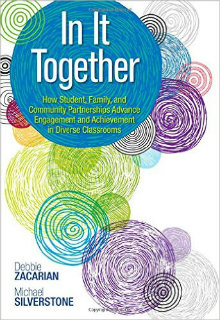Partnering with Families for Student Success
In It Together: How Students, Family, and Community Partnerships Advance Engagement and Achievement in Diverse Classrooms
By Debbie Zacarian and Michael Silverstone
(Corwin, 2015 – Learn more)
 Reviewed by Deb Hubble
Reviewed by Deb Hubble
The title of this book very well sums up its contents: it is about school and community partnerships that are two-way relationships with the goal of increased student achievement, both academic and social.
The authors provide case study samples of how tapping into various stakeholder groups can improve the effectiveness of schools, and offer questions and space in each chapter for readers to reflect on their own school-community relations.
Zacarian and Silverstone use the “sphere of influence” concept to describe the varying impact of diverse family and community groups and supply specific examples of how schools can better meet the needs of these groups by acknowledging these variances.
Two-way communication

In order to make the engagement of students and families meaningful in schools, the authors suggest three research-based practices: making connections, keeping students’ stress levels low, and valuing the assets within and beyond the classroom. By building on the previous experiences of students and their parents, teachers can make lessons and information more meaningful. While some families’ experiences mirror what is done in school, others do not – but these experiences are nonetheless valuable.
Replacing stress with nurture
Relative to stress levels, the authors cite studies on the reflexive response (fight/flight) and the reflective response. When teachers threaten and students feel stressed, students are unable to think and process because they are in a reactive state. On the other hand, when teachers nurture, greet students, and show personal interest, students’ brains are literally better prepared to think deeply, to reason, to problem-solve.
Likewise with parents; when they feel welcome and valued in a classroom, they are more capable of serving effectively. When the practices in a classroom do not match those in students’ home – such as when parents are illiterate, teachers can develop creative ways to still communicate about life in the classroom.
An example shared in the book is one of a teacher who had each cooperative group of students create a video to explain mitosis and meiosis. At Open House, parents were shown the videos and in turn, created video responses for their students about the students’ projects. This interactive nature of parent-student learning is emphasized throughout the book. By acknowledging and tapping into these “funds of knowledge” that ALL parent/community members can offer, the possibilities are endless.
Building trust school & community wide
Chapter 4 is full of many practical examples of ways teachers can connect with students, from end-of-summer surveys, questionnaires, and phone calls to student homes, to home visits and ideas for more interactive Open Houses. Chapter 5 continues with multiple ways to use the climate of trust and community to promote the academic success of all learners.
Examples include imparting the positive message that all learn can learn, creating a community of learners, and making learning socially relevant, to name a few. These two chapters would be valuable in a staff meeting, as teams or departments of teachers could work together to self-assess and set goals for the upcoming semester of how to REALLY enrich students and their families. Multiple ideas abound in these chapters!
The text continues with the nitty gritty details of how a school can take a scholastic calendar and literally plot community events to effectively reach the most people. The authors differentiate among events for various purposes: for social reasons, to make learning transparent, to draw on the rich resources of families, and to build a shared culture of learning. Such events widen the circle beyond the classroom, engaging parents in all aspects of their children’s development and growth.
The potential of service learning
The final chapters of this book tie in the importance of service learning, citing its usefulness to the community, connections to curriculum, emphasis on student reflection, promotion of student ownership and leadership, comprehensive planning by teachers, and adult involvement in the lives of students. A protocol for service learning projects is provided – helpful for any teacher embarking on such for the first time.
Finally, Zacarian and Silverstone suggest the book study format of professional development to truly help teachers make this work their own. Specific activities are provided as action steps for each chapter. As is the case with any professional learning, our task is to read/study/collaborate and then incorporate our new learning into something we can apply. Schools willing to tackle this particular study will end up with a clearer definition of what it means to be “in it together” in education.
Deb Hubble is an elementary principal in a large suburban Houston school district, Katy ISD. Her previous educational roles include special education teacher, librarian, district Language Arts curriculum coordinator, campus-based literacy coach, writer of abstracts for Effective Schools. She is also a published author for Corwin Press. While her work experience has been at the elementary level, Deb lives with her husband and four teenagers, making her somewhat of an expert on matters related to middle school. She can be found on Twitter @Debhubble1.





























